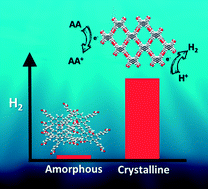当前位置:
X-MOL 学术
›
J. Mater. Chem. A
›
论文详情
Our official English website, www.x-mol.net, welcomes your feedback! (Note: you will need to create a separate account there.)
Photocatalytic proton reduction by a computationally identified, molecular hydrogen-bonded framework
Journal of Materials Chemistry A ( IF 11.9 ) Pub Date : 2020/03/20 , DOI: 10.1039/d0ta00219d Catherine M. Aitchison 1, 2, 3, 4 , Christopher M. Kane 1, 2, 3, 4 , David P. McMahon 4, 5, 6, 7, 8 , Peter R. Spackman 4, 5, 6, 7, 8 , Angeles Pulido 4, 5, 6, 7, 8 , Xiaoyan Wang 1, 2, 3, 4 , Liam Wilbraham 4, 9, 10, 11 , Linjiang Chen 1, 2, 3, 4, 12 , Rob Clowes 1, 2, 3, 4 , Martijn A. Zwijnenburg 4, 9, 10, 11 , Reiner Sebastian Sprick 1, 2, 3, 4 , Marc A. Little 1, 2, 3, 4 , Graeme M. Day 4, 5, 6, 7, 8 , Andrew I. Cooper 1, 2, 3, 4, 12
Journal of Materials Chemistry A ( IF 11.9 ) Pub Date : 2020/03/20 , DOI: 10.1039/d0ta00219d Catherine M. Aitchison 1, 2, 3, 4 , Christopher M. Kane 1, 2, 3, 4 , David P. McMahon 4, 5, 6, 7, 8 , Peter R. Spackman 4, 5, 6, 7, 8 , Angeles Pulido 4, 5, 6, 7, 8 , Xiaoyan Wang 1, 2, 3, 4 , Liam Wilbraham 4, 9, 10, 11 , Linjiang Chen 1, 2, 3, 4, 12 , Rob Clowes 1, 2, 3, 4 , Martijn A. Zwijnenburg 4, 9, 10, 11 , Reiner Sebastian Sprick 1, 2, 3, 4 , Marc A. Little 1, 2, 3, 4 , Graeme M. Day 4, 5, 6, 7, 8 , Andrew I. Cooper 1, 2, 3, 4, 12
Affiliation

|
We show that a hydrogen-bonded framework, TBAP-α, with extended π-stacked pyrene columns has a sacrificial photocatalytic hydrogen production rate of up to 3108 μmol g−1 h−1. This is the highest activity reported for a molecular organic crystal. By comparison, a chemically-identical but amorphous sample of TBAP was 20–200 times less active, depending on the reaction conditions, showing unambiguously that crystal packing in molecular crystals can dictate photocatalytic activity. Crystal structure prediction (CSP) was used to predict the solid-state structure of TBAP and other functionalised, conformationally-flexible pyrene derivatives. Specifically, we show that energy–structure–function (ESF) maps can be used to identify molecules such as TBAP that are likely to form extended π-stacked columns in the solid state. This opens up a methodology for the a priori computational design of molecular organic photocatalysts and other energy-relevant materials, such as organic electronics.
中文翻译:

通过计算确定的分子氢键构架进行光催化质子还原
我们显示,具有扩展的π堆积pyr柱的氢键键合结构TBAP - α具有高达3108μmolg -1 h -1的牺牲光催化氢产生速率。这是报道的分子有机晶体的最高活性。相比之下,根据反应条件的不同,化学性质相同但无定形的TBAP样品的活性要低20-200倍,明确表明分子晶体中的晶体堆积可以决定光催化活性。晶体结构预测(CSP)用于预测TBAP的固态结构和其他功能化,构象柔性的pyr衍生物。具体而言,我们表明,能量-结构-功能(ESF)映射可用于识别可能以固态形式形成扩展π堆积列的分子,例如TBAP。这为分子有机光催化剂和其他与能源相关的材料(例如有机电子)的先验计算设计开辟了一种方法。
更新日期:2020-04-15
中文翻译:

通过计算确定的分子氢键构架进行光催化质子还原
我们显示,具有扩展的π堆积pyr柱的氢键键合结构TBAP - α具有高达3108μmolg -1 h -1的牺牲光催化氢产生速率。这是报道的分子有机晶体的最高活性。相比之下,根据反应条件的不同,化学性质相同但无定形的TBAP样品的活性要低20-200倍,明确表明分子晶体中的晶体堆积可以决定光催化活性。晶体结构预测(CSP)用于预测TBAP的固态结构和其他功能化,构象柔性的pyr衍生物。具体而言,我们表明,能量-结构-功能(ESF)映射可用于识别可能以固态形式形成扩展π堆积列的分子,例如TBAP。这为分子有机光催化剂和其他与能源相关的材料(例如有机电子)的先验计算设计开辟了一种方法。



























 京公网安备 11010802027423号
京公网安备 11010802027423号